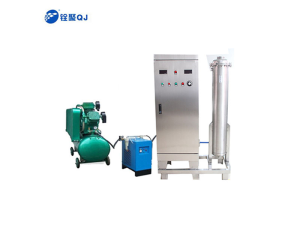As we all know, ozone plays a very important role in preventing the deterioration of health products such as food, medicine, cosmetics, etc., and can significantly extend the shelf life of food. According to Mr. Zhou Lifa, a food safety engineer from Shanghai Kangjiu Disinfection Technology Co., Ltd., who specializes in developing food safety solutions, the main reason why ozone can prolong the shelf life of food is due to its highly effective sterilization and disinfection effects. In addition to sterilization, ozone also has the effects of eliminating indoor and outdoor odors, decomposing harmful substances, treating sewage, and bleaching. Although ozone has been used in production and life for a long time, many people still don't know how ozone is produced from the ozone generator, and the circuit structure of the ozone generator is also unclear.
1. The generation principle of ozone
Ozone is a strong oxidant, obtained through high-pressure ionization (or electrolysis, chemical, photochemical reactions), and its production process is to decompose part of the oxygen in the air into oxygen atoms, and these oxygen atoms and oxygen molecules polymerize into ozone.
The nature of ozone is extremely unstable and will quickly decompose after production. Therefore, ozone can only be produced and used. The equipment that produces ozone is called an ozone generator. According to the different ways of ozone generation, ozone generators are mainly divided into three types: high-voltage discharge ozone generator, electrolytic ozone generator, and ultraviolet irradiation ozone generator.
2. Circuit structure of ozone generator
The ozone generator circuit consists of a push-pull oscillation circuit composed of transistors VT1 and VT2, inductance coil L1-13, pulse transformer T, current limiting resistor R1, charging capacitor C3, and two-way trigger diode 叨5; filter inductor coil L0, rectifier diode VD1 It forms a half-wave rectifier filter circuit with filter capacitors C1 and C2. Switch on the power supply, the AC 220V voltage is filtered by LO, and after VD1 rectification, a voltage of about ten 280V is generated at both ends of C1, which is supplied to the push-pull oscillation circuit. At the moment of starting, VT1 is turned on. Due to the charging effect of C3, the bidirectional trigger diode VD5 is cut off.
When the charging voltage across C3 rises to 32V, VD5 is triggered and turned on, making VT2 turn on. During the VT2 conduction period, C3 gradually discharges, and VT2 is turned off. After VT1 is turned on, under the action of the pulse transformer T, a positive feedback voltage is generated on L1 and L2. This voltage is added to the bases of VT1 and VT2, so that VT1 and VT2 are turned on and off alternately (that is, when VT1 is turned on, VT2 is cut off; when VT2 is on, VTl is cut off), the push-pull oscillation circuit oscillates. After the push-pull oscillation circuit works, a pulse high voltage is generated on the secondary winding L6 of the pulse transformer T, so that the ozone generator VG works to generate ozone.
At the same time, the light-emitting diode VD7 also lights up. The components and parts choose VTl, VT2 to choose 2SC2653 or BU406 silicon NPN high back pressure triode. The current amplification factor β>100 is required. VDl-VD4, VD6 select 1 N4007 type rectifier diode; VD5 selects DB3 type bidirectional trigger diode. R1 to R6 all use RJ-1/8W metal film resistors. L0 is a 5mH magnetic core inductance coil, which can be wound on the skeleton with 210 turns of Φ0.25mm enameled wire; L1 is made of Φ0.2mm single-core plastic copper wire wound on the same magnetic ring, of which L1 and L2 are respectively wound 3 turns, 9 turns around L3. The pulse transformer T can be reformed with 14in (inch) black and white TV line output transformer. When reforming, the high-voltage package is used as L6, the low-voltage package frame is wound with Φ0.45mm enameled wire with 168 turns as L4, and the Φ0.23mm enameled wire is wound 4 The turn is L5 (wound on the outer layer). The ozone generator VG selects models such as Z-10 or Z-15, Z-20.
Except for the ozone generator VG, all electronic components are installed on a self-made printed circuit board, and then packed into a plastic or wooden box of appropriate size. Open a hole on the box surface to fix the light-emitting diode VD7, and connect the ozone generating sheet VG. As long as the components are good and the wiring is correct, it can work when it is powered on.


